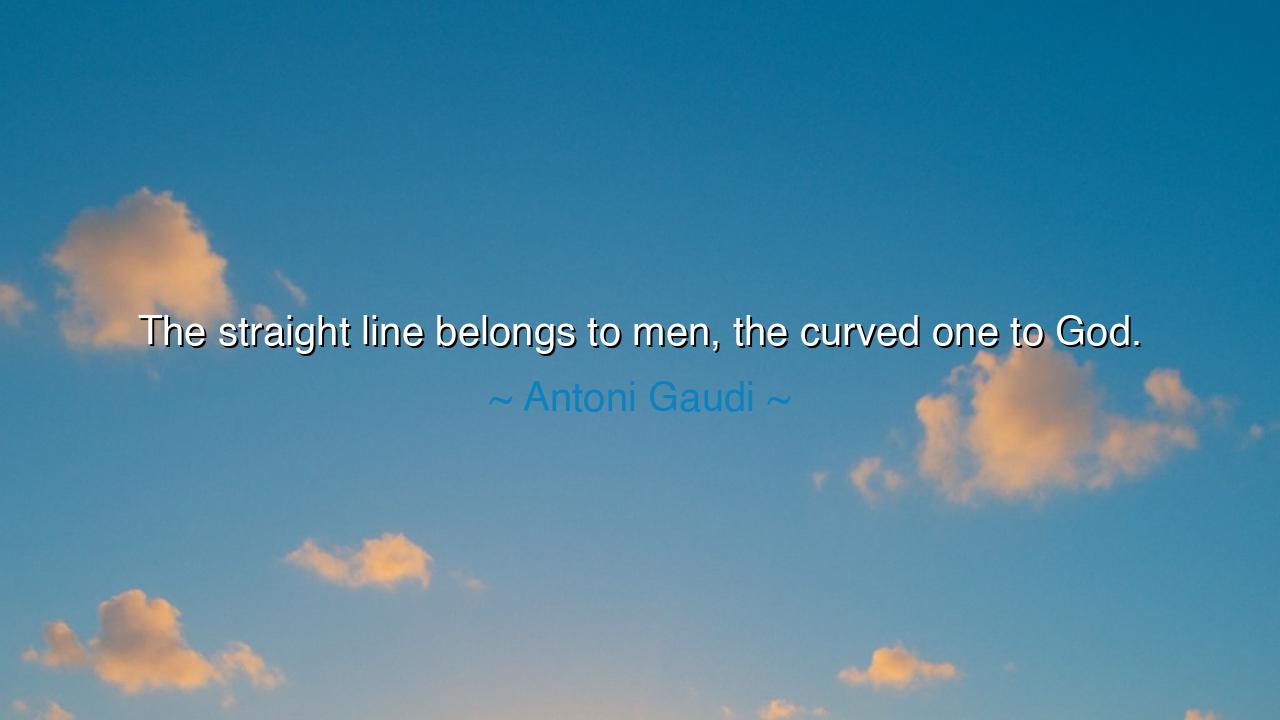
The straight line belongs to men, the curved one to God.






The words of Antoni Gaudí, the master of form and devotion, speak to the union of human effort and divine inspiration: “The straight line belongs to men, the curved one to God.” In this reflection lies a profound understanding of the limits and possibilities of human creativity. Gaudí, whose architecture transformed Barcelona into a living cathedral of imagination, recognized that the straight line—orderly, predictable, and confined—represents human mastery over space and reason. Yet the curved line, flowing and organic, is the signature of the divine, the reflection of life’s eternal rhythm and the infinite complexity of creation.
The origin of this quote lies in Gaudí’s revolutionary approach to architecture in the late 19th and early 20th centuries. He was deeply inspired by nature and believed that God’s presence is manifest in the organic forms that surround us—trees, waves, shells, and bones. Unlike the rigid geometries favored in conventional design, Gaudí allowed the natural curves of life to guide his work. His buildings, most famously the Sagrada Família, twist and rise with a rhythm reminiscent of growing trees and flowing rivers, revealing a language that speaks of divine creativity, surpassing the constraints of human design.
At the heart of this teaching is the principle of humility before creation. The straight line may symbolize human intellect, calculation, and control. It represents structures we can measure, predict, and master. But the curved line—the one that bends, flows, and surprises—is a manifestation of God’s infinite imagination. Gaudí teaches that the truly transcendent arises not from rigid discipline alone, but from surrendering to the wisdom, rhythm, and beauty inherent in the world. To embrace the curved line is to embrace the divine in all things.
History provides examples that illuminate this vision. Consider Leonardo da Vinci, who studied the spiral of seashells, the flow of rivers, and the anatomy of the human body, seeking to understand the divine geometry of nature. Like Gaudí, Leonardo recognized that true artistry lies not in imposing rigid structures, but in harmonizing with the patterns and curves found in creation. In both men’s works, the straight line is a tool, but the curve is the inspiration, revealing that the beauty of life cannot be fully captured by human measurement alone.
Gaudí’s words carry emotional resonance because they remind us that life itself is not always linear. The path of existence twists, turns, and unfolds in unpredictable ways, reflecting the divine complexity of the universe. To live fully, one must learn to navigate these curves with faith, creativity, and openness. The straight line may guide us, but it is the curve that teaches wonder, humility, and awe at the forces that shape our lives beyond our comprehension.
The lesson in Gaudí’s reflection is both spiritual and practical. Embrace creativity that flows with life, honor inspiration that emerges from observation and humility, and recognize the limits of pure human logic. When designing, creating, or making decisions, leave space for the unexpected, for beauty often arises from forms and paths that cannot be entirely planned. The curved line invites flexibility, attention, and reverence, reminding us that mastery is not about control alone, but about harmony with the divine patterns of the world.
Practically, one might cultivate this perspective by observing nature, studying forms, and allowing intuition to guide action alongside reason. Architects, artists, and innovators can let the curves of rivers, trees, and human movement inform their creations. In everyday life, one might recognize the unpredictable twists of relationships, challenges, and opportunities as manifestations of a greater design. By honoring the curved line, we learn patience, creativity, and the art of co-creation with forces beyond our control.
Thus, the words of Antoni Gaudí endure as both a meditation and a guide: “The straight line belongs to men, the curved one to God.” Let them teach us to balance intellect with inspiration, order with fluidity, and discipline with reverence for the divine. In every curve we encounter or create—be it in stone, thought, or action—we glimpse the infinite, and in this recognition, our work, our lives, and our spirits are elevated toward the eternal.






AAdministratorAdministrator
Welcome, honored guests. Please leave a comment, we will respond soon